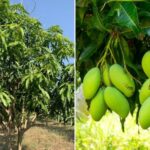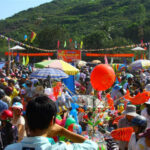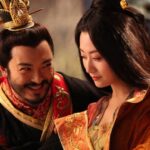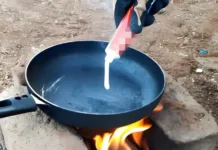Dinh Market – A Living Museum of Nam Dinh Culture
According to local historical documents, Dinh Market in Nam Lang has its roots in the 15th century, associated with the worship of the God Hoang Quy Trieu Dai Vuong – a figure considered to be the brother of Tan Vien Son God in folk beliefs. Legend has it that the God taught the locals how to control water, helping them escape from floods and poor harvests. To commemorate this merit, the villagers built a temple and organized an annual festival, including a special market on the second day of the first lunar month.

In its journey of development, Dinh Market in Nam Lang has evolved from a simple place for exchanging agricultural products and labor tools into a symbolic “lucky” market. Locals believe that shopping here at the beginning of the year will bring fortune and ward off misfortune for the entire year.
Dinh Market in Nam Lang has been recognized as an intangible cultural heritage at the provincial level, serving as a vivid testament to the ancient rice civilization of the Hong River Delta people. Interestingly, despite enduring for hundreds of years, the market has preserved much of its original charm.
A Unique Cultural Space in the Heart of the Countryside
The Dinh Market area is located near the Nam Lang communal house complex, where Hoang Quy Trieu Dai Vuong is worshipped. This land belongs to the Hong River Delta, with a dense system of rivers and canals, forming a unique rice civilization.
Upon entering the market space, visitors are captivated by the diversity of traditional items on offer. Here, one can find a variety of religious artifacts such as altar paintings, Buddha statues, lucky charms, and votive paper; agricultural tools like hoes, plows, and sickles – symbolizing diligent labor; and ornamental plants like apricot, peach, and kumquat trees, symbolizing prosperity.

Notably, Dinh Market in Nam Lang is also famous for its mouthwatering local specialties. Among them, one must mention Ba Thin’s traditional square sticky rice cakes with seasoned pork belly filling, wrapped in dong leaves; xiu bao cakes with a crispy shell and mung bean or pork filling, originating from Chinese cuisine; and peanut brittle – a rustic snack handmade from roasted peanuts and malt.
The culinary space at the market also reflects the distinctive Nam Dinh cuisine, featuring dishes such as bun dua (thick rice noodles served with broth made from pork bones and fish cakes), Nam Dinh beef pho (differing from Hanoi pho with a richer broth thanks to the use of beef bones and special spices), and che kho (a type of pudding made from cassava flour, mung beans, and grated coconut).
Current Status and Challenges in Preservation Efforts
According to statistics from the Department of Culture, Sports, and Tourism of Nam Dinh province, during the Tet holiday, Dinh Market in Nam Lang attracts approximately 5,000-7,000 visitors, mostly locals and tourists from neighboring provinces. It is considered a must-visit destination when exploring Nam Dinh’s culture, along with the Phu Day temple complex and Tran Temple.
However, in the context of rapid urbanization, Dinh Market in Nam Lang faces the risk of fading away. Many modern stalls are replacing the traditional ones, altering the intrinsic beauty of this ancient market.
This situation calls for special attention from local authorities and the community. The preservation and promotion of Dinh Market in Nam Lang have become pressing issues for this unique cultural heritage.
A Special Experience for Visitors
Visiting Dinh Market in Nam Lang offers visitors not only the opportunity to shop for traditional products but also to engage in unique cultural experiences.
One of the unmissable activities is the ritual of carrying the God’s palanquin from Nam Lang Temple to the communal house, which takes place on the night of the first day of the lunar new year. This ceremony is accompanied by lion dancing, drum performances, and ancient chau van songs, creating a solemn and colorful atmosphere.

Moreover, buying an item at Dinh Market is not just a transaction but also an act of “buying luck.” Many people choose to purchase a bunch of green bananas (symbolizing reunion) or a stalk of sugarcane (symbolizing a “sweet” path to fortune) with the belief that it will bring good things in the coming year.
Dinh Market in Nam Lang is also an ideal place for visitors to interact with locals, learn about ancestor worship customs, and discover folk stories surrounding Hoang Quy Trieu Dai Vuong.
Tips for Visitors
To have a complete experience at Dinh Market in Nam Lang, visitors should keep in mind the following:
– Ideal time: It is recommended to arrive at the market between 3 and 5 am on the second day of the first lunar month to attend the opening ceremony and avoid the crowds.
– Choosing specialties: Opt for handmade products such as sticky rice cakes wrapped in dong leaves or traditionally packaged peanut brittle to ensure quality and contribute to the preservation of local handicrafts.
– Cultural etiquette: According to local beliefs, the first day of the year is considered a day of “buying luck and selling misfortune.” Therefore, visitors should refrain from haggling over prices.
– Combining sightseeing: After visiting the market, take time to explore the Nam Lang communal house or the Temple of Saint Mau Lieu Hanh, located 15km away, to gain a deeper understanding of the local religious culture.
“Should You Plant a Mango Tree in Your Front Yard?”
The mango tree has long been an integral part of Vietnamese culture and lifestyle, offering not just economic and culinary value but also holding deep symbolic significance in feng shui. Is it auspicious to plant a mango tree in front of your house? Let’s delve into this intriguing question and uncover the answers within.
The Tenacious Cactus: A Beauty with a Thorny Secret.
“Planting ornamental plants in front of your house is not just about aesthetics. It’s about creating a harmonious environment that aligns with the principles of feng shui and promotes safety. That’s why, according to ancient wisdom, cacti and other thorny plants are not recommended for the front yard. It’s all about striking a balance between beauty and positive energy flow.”
The Weird and Wonderful New Year’s Day Market: Ranked in the “Top 100 Unique Markets of Vietnam”
Chợ Gò is a unique market that springs to life on the first day of the Lunar New Year in the land of Binh Dinh, renowned for its martial arts and literary heritage. Steeped in history, dating back to the time of the Tay Son brothers’ uprising, this market is not just a place for trading and exchanging New Year blessings. It is a vibrant hub where traditional values and the festive spirit of spring converge, leaving an indelible mark on the cultural landscape of this region.
Money-Attracting Power of the Schisandra Chinensis: A Wealth-Guarding Plant to Grow
“Echinacea, also known as the ‘Wonder Drug’, is a powerful herb with a plethora of health benefits. With its potent properties, it has been likened to a ‘panax ginseng’ of the plant world. In traditional practices, Echinacea is believed to bring good fortune and prosperity to those who grow it, with its strong and resilient nature symbolizing longevity and abundance.”






































